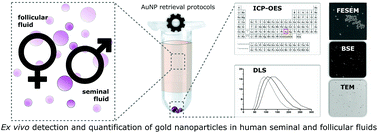Our official English website, www.x-mol.net, welcomes your feedback! (Note: you will need to create a separate account there.)
Ex vivo detection and quantification of gold nanoparticles in human seminal and follicular fluids†
Analyst ( IF 4.2 ) Pub Date : 2017-12-01 00:00:00 , DOI: 10.1039/c7an01641g Dimitrios Bitounis 1, 2, 3, 4, 5 , Jean-Philippe Klein 1, 2, 3, 4, 5 , Lionel Mery 5, 6, 7, 8 , Amira El-Merhie 5, 9, 10, 11, 12 , Valérie Forest 5, 9, 10, 11, 12 , Delphine Boudard 1, 2, 3, 4, 5 , Jérémie Pourchez 5, 9, 10, 11, 12 , Michèle Cottier 1, 2, 3, 4, 5
Analyst ( IF 4.2 ) Pub Date : 2017-12-01 00:00:00 , DOI: 10.1039/c7an01641g Dimitrios Bitounis 1, 2, 3, 4, 5 , Jean-Philippe Klein 1, 2, 3, 4, 5 , Lionel Mery 5, 6, 7, 8 , Amira El-Merhie 5, 9, 10, 11, 12 , Valérie Forest 5, 9, 10, 11, 12 , Delphine Boudard 1, 2, 3, 4, 5 , Jérémie Pourchez 5, 9, 10, 11, 12 , Michèle Cottier 1, 2, 3, 4, 5
Affiliation

|
Increasing consumption of engineered nanoparticles and occupational exposure to novel, ultrafine airborne particles during the last decades has coincided with deterioration of sperm parameters and delayed fecundity. In order to prevent possible adverse health effects and ensure a sustainable growth for the nanoparticle industry, the ability to investigate the nanosized, mineralogical load of human reproductive systems is becoming a real clinical need. Toward this goal, the current study proposes two methods for the detection and quantification of engineered nanoparticles in human follicular and seminal fluid, developed with the use of well-defined 60 nm Au particles. Despite the complexity of these biological fluids, simple physical and chemical treatments allow for the precise quantification of more than 50 and 70% wt of the spiked Au nanoparticles at low μg ml−1 levels in follicular and seminal fluids, respectively. The use of electron microscopy for the detailed observation of the detected analytes is also enabled. The proposed method is applied on a small patient cohort in order to demonstrate its clinical applicability by exploring the differences in the metal and particulate content between patients with normal and low sperm count.
中文翻译:

人精液和卵泡液中金纳米颗粒的离体检测和定量†
在过去的几十年中,工程化纳米颗粒的消耗增加,职业性接触新型超细空气传播颗粒,这与精子参数下降和生育力下降同时发生。为了防止可能的不利健康影响并确保纳米颗粒产业的可持续增长,研究人类生殖系统的纳米级矿物学负荷的能力已成为一种实际的临床需求。为了实现这一目标,当前的研究提出了两种检测和定量人卵泡液和精液中工程纳米颗粒的方法,这是通过使用定义明确的60 nm Au颗粒而开发的。尽管这些生物液体很复杂,卵泡液和精液中的-1水平分别较高。还可以使用电子显微镜对检测到的分析物进行详细观察。拟议的方法应用于一小群患者,以通过探究正常和低精子患者之间金属和微粒含量的差异来证明其临床适用性。
更新日期:2017-12-01
中文翻译:

人精液和卵泡液中金纳米颗粒的离体检测和定量†
在过去的几十年中,工程化纳米颗粒的消耗增加,职业性接触新型超细空气传播颗粒,这与精子参数下降和生育力下降同时发生。为了防止可能的不利健康影响并确保纳米颗粒产业的可持续增长,研究人类生殖系统的纳米级矿物学负荷的能力已成为一种实际的临床需求。为了实现这一目标,当前的研究提出了两种检测和定量人卵泡液和精液中工程纳米颗粒的方法,这是通过使用定义明确的60 nm Au颗粒而开发的。尽管这些生物液体很复杂,卵泡液和精液中的-1水平分别较高。还可以使用电子显微镜对检测到的分析物进行详细观察。拟议的方法应用于一小群患者,以通过探究正常和低精子患者之间金属和微粒含量的差异来证明其临床适用性。


























 京公网安备 11010802027423号
京公网安备 11010802027423号